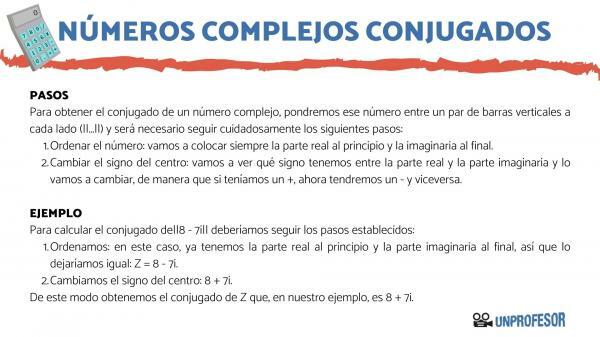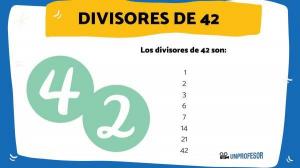What are complex numbers CONJUGATED with EXAMPLES and EXERCISES solved?

In this new lesson from a Teacher we are going to learn what complex numbers conjugated with examples so you can know how we can obtain the conjugate of complex or imaginary numbers. First of all, we will see what steps should we follow to extract the conjugate of a complex number. Next, we will do the same, but instead of with a single imaginary number, with operations of imaginary numbers. In each of these sections we will see examples and, finally, you can solve a exercise and check that you have done well with the solutions that you will find at the end.
To obtain the conjugate of a complex number, we will put that number between a pair of vertical bars on each side (||... ||) and it will be necessary to carefully follow the following steps:
- Order the number: let's place forever the real part at the beginning and the imaginary part at the end.
- Change sign from the center: we are going to see what sign we have between the real part and the imaginary part and we are going to change it, so that if we had a +, now we will have a - and vice versa.
Examples of operation with conjugated complex numbers
It is important to note that complex numbers they are usually represented using the letter Z, so for example we could have Z = 8 - 7i. In this case, if they asked us to calculate the conjugate, they would tell us || 8 - 7i || and we should follow the established steps:
- We order: in this case, we already have the real part at the beginning and the imaginary part at the end, so we would leave it the same: Z = 8 - 7i.
- We change the sign of the center: 8 + 7i.
In this way we obtain the conjugate of Z which, in our example, is 8 + 7i.
Let's see another example of something else. If the complex number they give us is Z = - 32i - 12, the steps will be like this:
- We order: in this example it is necessary to order, since the imaginary part is in front, so we will change it to Z = - 12 - 32i.
- Now we can change the sign of the center. Since we had a minus, we will change it to a plus: - 12 + 32i.
We have already seen that obtaining complex conjugated numbers is something quite simple, since there are only two steps to follow. Now we are going to add a little difficulty: instead of having a single complex number, we will have a pair that will be adding or subtracting. The steps in this case would be the following:
- Placeand group the real part on the one hand and the imaginary part on the other.
- Order, as we did in the previous section.
- Change sign, in the same way.
Example 1
Let's look at an example. If they ask us to make the conjugate of the sum between Z1 = 4i + 5 and Z2 = - 7 - 3i:
- We are going to place what they are asking us, which is: (4i + 5) + (- 7 - 3i). If we group the real part, we are left with + 5 - 7, which is equal to -2. If we group the imaginary part, we are left with 4i - 3i, which is equal to i.
- We order, writing first the real part and then the imaginary part: - 2 + i.
- We change the sign: - 2 - i.
Example 2
Let's look at an example in which, instead of having two complex numbers added together, we have them subtracted. In this sense, it is very important that you are clear about how positive and negative numbers are added or subtracted. You can take a look at the article What are whole numbers. Thus, if they ask us for the conjugate of the subtraction between Z1 = 2 - 3i and Z2 = 6 - 9i:
- We place: (2 - 3i) - (6 - 9i). Whenever we have a negative sign in front of a parenthesis, we must change the sign of everything inside the parenthesis, so that we will have (2 - 3i) + (- 6 + 9i). Now we can group the real part, which will remain 2 - 6, that is, -4; and the imaginary part, which will remain - 3i + 9i, which will remain with 6i.
- We order: - 4 + 6i.
- We change the sign: - 4 - 6i.
Example 3
If they ask us to conjugate a complex number and then subtract or add another complex number, we will follow the steps for the first and, later, we will group the real part of the result with that of the second complex number on the one hand, and the imaginary part by other. You will see it more clearly with the following example: obtain the conjugate of Z1 = 20i - 7 and then add the complex number Z2 = 42 + 7i.
- We calculate the conjugate of Z1, which would give us - 7 - 20i.
- We add Z2: (- 7 - 20i) + (42 + 7i) = 35 - 13i.

To finish this lesson, we are going to leave you 4 exercises on complex conjugated numbers that will help you test your knowledge. In the next section you will find the solutions of the exercise so that you can check your results:
- Calculate the conjugate of 86i - 6
- Find the conjugate of the sum between 67 + 7i and - 5 + 2i
- Find the conjugate of the subtraction between 5i - 8 and 9i + 2.
- Find the conjugate of 12i - 3 and subtract 8 + 2i.



